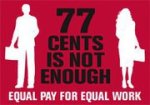According to the National Center for Educational Statistics:
- Female high school graduates are more likely than male graduates to have taken geometry, algebra II, pre-calculus, biology, and chemistry.
- Females are more likely than their male classmates to participate in music or performing arts, belong to academic clubs, work on the school yearbook or newspaper, or participate in student government.
And last year The White House’s Women in America Report noted that those trends continue in college:
- Greater percentages of females attend college.
- Females are more likely to attend and graduate from college without dropping out.
- Females are more likely to earn a graduate school degree.
And the 2010 “Women in the Labor Force: A Databook,” compiled by the U.S. Bureau of Labor Statistics reflects similar developments in the workforce:
- Women account for 51 percent of all people employed in management, professional, and related occupations, somewhat more than their share of total employment (47 percent).
- The increase in female managers coming to the table with undergraduate and graduate degrees is greater than the increases in male managers.
So, are you ready for reality?
- Women earn 77 percent of what men earn.
- Equal Pay Day, which signifies the point into the year that a woman must work to earn what a man made, falls on Tuesday, April 17 this year.
Wait, what? That’s right; and it’s not what you were expecting, is it?
Truth be told, we should expect more for our working women, and they should get more. Nearly 50 years ago, when the Equal Pay Act of 1963 brought pay parity for women to the national forefront, critics argued that women simply did not have the same educational background as men, and therefore did not merit the same wages. Well, instead of coming a long way, baby, it seems we have come full circle.
Today’s critics of equal pay argue that men as a group earn higher wages in part because men dominate blue collar jobs, which are more likely to require payments for overtime work. In contrast, women comprise more of the salaried white collar management workforce that is often exempted from overtime laws.
We were told that we didn’t have enough education to merit equal pay then, and now our educational achievements are the cause of the disparity. Well, the critics want it both ways. The Paycheck Fairness Act, which would have toughened legal action against discriminating employers, still hasn’t been passed by the Congress. Many businesses continue to oppose it, citing that new legislation is unnecessary, redundant, and would simply lead to unfair lawsuits against employers.
 Then why, nearly 50 years later, has the wage gap only improved by only half a cent per year? In 1963, according to the National Committee on Pay Equity, “women working full-time and year-round earned on average 59 cents for every dollar earned by men. A woman now earns 77 cents for every man’s dollar.” At that rate, it will take nearly another half-century for women to earn a fair wage.
Then why, nearly 50 years later, has the wage gap only improved by only half a cent per year? In 1963, according to the National Committee on Pay Equity, “women working full-time and year-round earned on average 59 cents for every dollar earned by men. A woman now earns 77 cents for every man’s dollar.” At that rate, it will take nearly another half-century for women to earn a fair wage.
In that same time frame, women have made tremendous strides and are more likely than males to enter the workforce with degrees from high school, college, and graduate school. It makes good financial sense for businesses to invest in attracting and retaining the best talent by offering equal and fair compensation and benefits. Many forward looking businesses recognize that eliminating pay differentials makes good business sense and that pay equity can help with competitiveness, worker retention and productivity.
It’s time for all of America’s business community to step up with fair pay, or step out of the way of legislation like the Paycheck Fairness Act that will help ensure pay equity. I call on all businesses, on Equal Pay Day this year, to review compensation packages and address the inequality. We can help.
BPW Foundation encourages employers to recognize and reward the skills and contributions of working women. The Employer Pay Equity Self-Audit was developed to assist employers in analyzing their own wage-setting policies and establishing consistent and fair pay practices for all. It can be found on the BPW Foundation website. The Equal Opportunities Commission also offers an Equal Pay Self Audit Kit.
It’s the right thing to do for your employees. It’s the smart thing to do for your business.
Don’t let another year go by for working women — and their families — who are doing more for less. We held up our end of the bargain and came to the workforce better prepared and more skilled. Now it’s your turn: make sure you offer equal pay for equal work.
This article was adapted from a piece that first appeared on the Huffington Post, April 11, 2011. Cross posted from the blog of the Business and Professional Women's Foundation.


The views and opinions expressed in this post are those of the author(s) and do not necessarily reflect those of MomsRising.org.
MomsRising.org strongly encourages our readers to post comments in response to blog posts. We value diversity of opinions and perspectives. Our goals for this space are to be educational, thought-provoking, and respectful. So we actively moderate comments and we reserve the right to edit or remove comments that undermine these goals. Thanks!